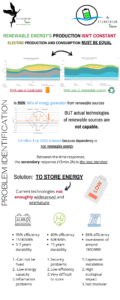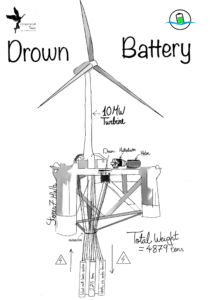Drown Battery (Super Powered)
Issue:
In the current transition to green and renewable energy as a replacement for the burning of fossil fuels, there is a major drawback: the generation of renewable energy is not constant.
the current transition to green and renewable energy as a replacement for the burning of fossil fuels, there is a major drawback: the generation of renewable energy is not constant.
The absence of a large-scale, cheap, reliable and durable storage system stands out.
- The most common currently are:
- Lithium batteries and derivatives: which have a high cost of ≈150kWh, use scarce and highly polluting materials, in addition to their inability to be used on a large scale.
- Hydroelectric: It has a very high initial investment cost, is poorly modular and affects fauna and river channels.
Therefore, there is a great disparity between production, demand and consumption of energy, this means that:
- When there is excess energy and low demand and consumption: waste of energy.
- When there is a shortage of production and high demand: we continue to depend on the burning of fossil fuels to supply.
All of this amounts to massive energy cost growth and an estimated $2.9 trillion in monetary losses.
Solution:
For this reason, we have designed a potential energy differential storage system that is added to Off-Shore wind turbines.
It consists of a set of 17 masses weighing a total of 4879 tons adjusted with Archimedes, these masses are hanging by means of marine chains to 3 sets of coils, motors, multipliers and power electronics on top of the wind turbine float. We reconvert 20 meter sections of old wind turbine towers as formwork for the reinforced concrete masses, and the mechanics of these old wind turbines are also reused. In this way we free up valuable wind points for the installation of new, more efficient machines and give a second life to components that would otherwise be discarded. The rest of the materials are common and non-polluting, such as steel or concrete.
The aim of this system is to stabilize the energy output flow of off-shore wind turbines and cover all non-production periods. It is an optimization of the Off-Shore wind turbines to increase their availability, this modification gives the operator much greater versatility.
- When there is energy surplus and low demand and/or consumption: The surplus is used to increase the weights with the motors.
- When there is production shortage and high demand: The lowering weights are released and generate power with the mechanics.
- The system also covers curtailments, maintenance, extra storage for the grid and can be used for trade-off.
It takes advantage of the great depth of the sea 600 meters and the excess buoyancy of the Off-Shore wind turbines, it also adds a redirection in the center of gravity that works as a centerboard reducing the bending moment.
This battery can store about 7 MWh. The battery can make up for the lack of energy from the wind turbine for 1h and 30 mins.
The advantage of this battery is that it can be cycled indefinitely without losing performance, this battery is designed to last about 30 years, during this time it would have needed 5 equivalent lithium batteries.
(How the float is modified)
The final price of this system is 2.3 million $, representing only a 4.2% increase over the price of the 10Mw wind turbine where it is installed. The final price of the system is 300 € Kwh including installation, transport, power electronics, infrastructure and design costs.
